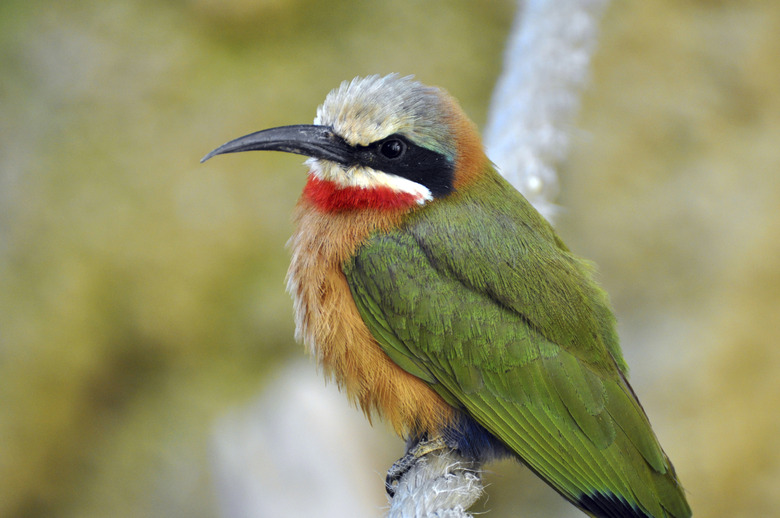What Kind Of Birds Eat Bees?
You might be surprised that any animal would want to eat bees, given the prevalence of stingers. Nevertheless, several animals do. In fact, a number of birds include bees as a substantial part of their diets.
TL;DR (Too Long; Didn't Read)
Several types of birds eat bees. Some birds' diets are made mostly of bees, such as bee-eaters and summer tanagers, while other birds eat them occasionally, either as adult insects or larvae.
Birds That Eat Bees
Birds That Eat Bees
Some bird species that eat bees are specialists while others are opportunists. Some prefer adult bees, and others consume bee larvae. Examples of birds that eat adult bees and wasps include bee-eaters, summer tanagers, scarlet tanagers and purple martins. One bird that prefers the larvae of bees and wasps is the honey buzzard.
Family Meropidae: The Bee-eaters
Family Meropidae: The Bee-eaters
The ultimate bee consumers, bee-eaters, are birds in the family Meropidae, with a whopping 22 species. Many reside in Africa. Most bee-eaters are vividly colored, quite vocal and highly sociable. They live in holes they dig in the earth, and they make egg chambers in these holes.
They are medium-sized birds that use their specialized, curved beaks to capture their prey. Bee-eaters take honeybees, flies and other insects.
A bee-eater uses two methods to take bees: It swoops from branches, or it glides to catch the bees right from the air. It then uses its curved beak to bash the bee's head on a surface, and rub off its stinger and toxins before eating the bee.
Summer Tanagers and Scarlet Tanagers
Summer Tanagers and Scarlet Tanagers
The summer tanager (Piranga rubra) and scarlet tanager (Piranga olivacea) are additional birds that eat bees.
The male summer tanager is a striking, solid red color while the female is more yellowish. Bees and wasps comprise the greater bulk of the summer tanager's diet. Summer tanagers consume bees and wasps in both their breeding and wintering grounds. This tanager will charge forth and snatch a bee, and bludgeon it on a branch or other surface. Summer tanagers also eat other types of insects and fruits.
The scarlet tanager is another striking bird. The male is brilliant red, with black wings and tail. The female scarlet tanager, however, bears soft yellow plumage with grayish wings and tail. The male and female scarlet tanager both sing to each other. The female scarlet tanager will also sing while she builds her nest from forest floor materials.
Scarlet tanagers, like summer tanagers, enjoy eating bees. They are not as famous for specific bee consumption, but they do like to hover in the air and catch bees, hornets and wasps occasionally. They press such insects into a branch to kill them.
Purple Martins, Occasional Bee Consumers
Purple Martins, Occasional Bee Consumers
Purple martins are opportunistic insectivores, eating all sorts of insects such as:
- dragonflies
- flies
- fire ants
- wasps
- bees
The Honey Buzzard
The Honey Buzzard
Birdwatchers in the United Kingdom may have witnessed the honey buzzard at work. Honey buzzards spend their summers in the UK and winters in Africa. They are large raptors, gray-brown in color with slender necks and long wings and tails.
Honey buzzards do not favor adult bees and wasps. But they will follow the adults back to their hives. There, the honey buzzard will use its claws to open up a nest and take the larvae of bees or wasps.
The honey buzzard possess specialized feathers on their faces, which work as a sort of armor against potential stings of the bees and wasps whose nests they raid.
As you can see, a broad range of fascinating birds eat bees either as their primary diet or as supplementary food. If you spot one of these birds in the wild, observe their feeding behavior and see what they catch.
References
- San Diego Zoo Animals & Plants: Bee-eater
- The Cornell Lab of Ornithology: All About Birds: Summer Tanager Life History
- The Cornell Lab of Ornithology: All About Birds: Scarlet Tanager Life History
- The Nature Conservancy Cool Green Science: Purple Martins: The Bird That Relies on Human-Built Nests
- The Wildlife Trusts: Honey Buzzard
Cite This Article
MLA
Hermance, Dianne. "What Kind Of Birds Eat Bees?" sciencing.com, https://www.sciencing.com/kind-birds-eat-bees-5647607/. 30 July 2019.
APA
Hermance, Dianne. (2019, July 30). What Kind Of Birds Eat Bees?. sciencing.com. Retrieved from https://www.sciencing.com/kind-birds-eat-bees-5647607/
Chicago
Hermance, Dianne. What Kind Of Birds Eat Bees? last modified March 24, 2022. https://www.sciencing.com/kind-birds-eat-bees-5647607/
